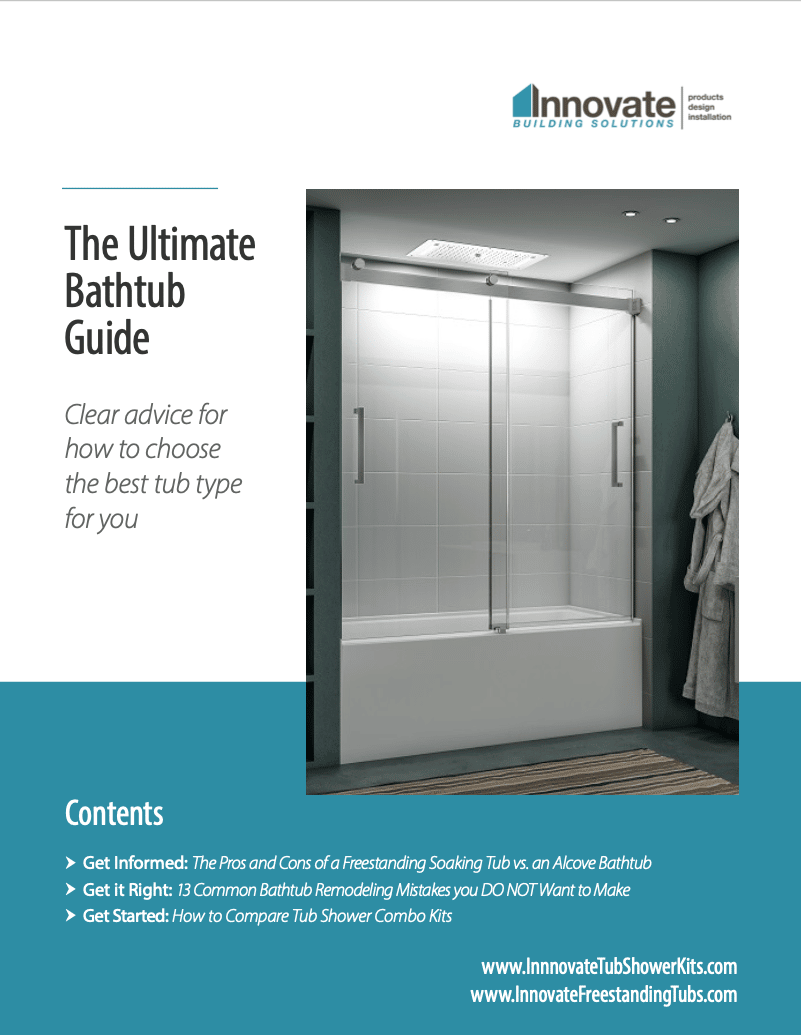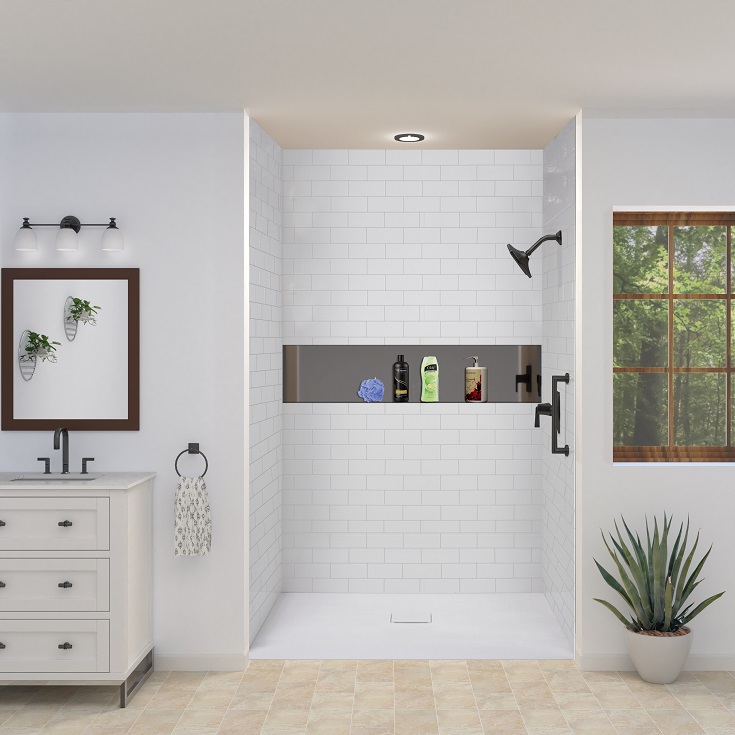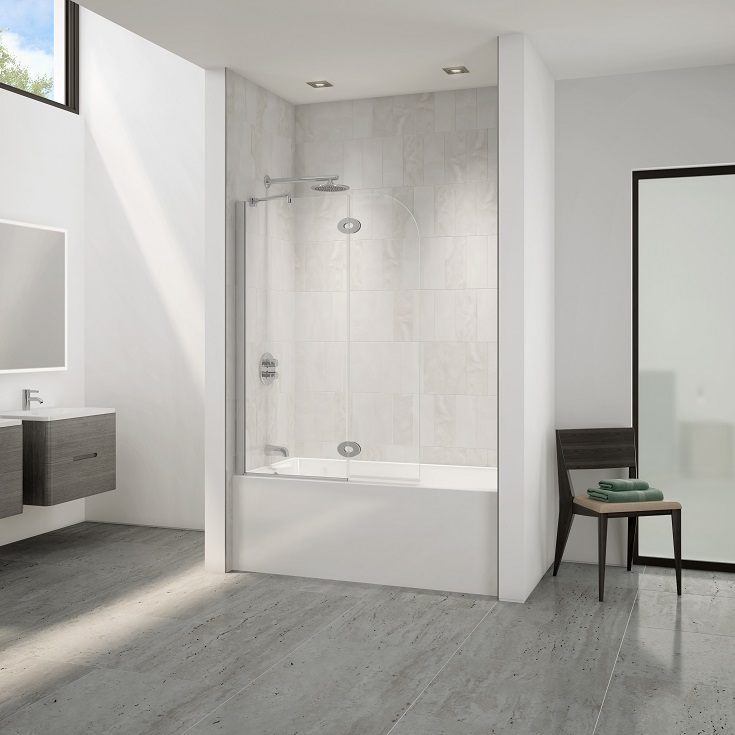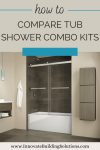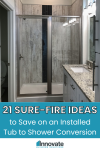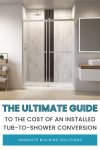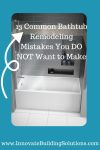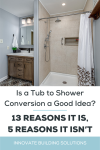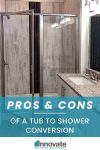The Pros and Cons of a Freestanding Soaking Tub vs. an Alcove Bathtub
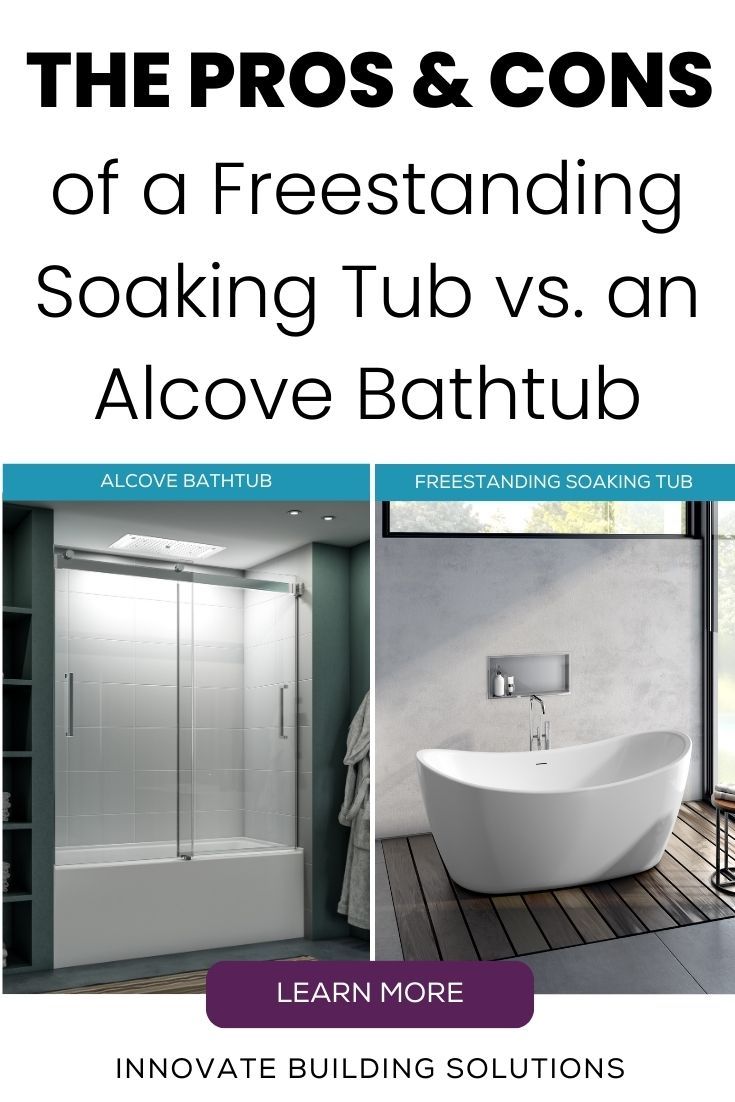
Why do bathroom remodeling projects (and products) have to be so doggone complicated?
If you’re remodeling, you may be struggling attempting to figure out the following:
- Should I choose a shower or bathtub? Or better yet, can I fit both?
- If I decide to use a tub – is it better to select a freestanding soaking tub which can go anywhere, or an alcove tub which is neatly tucked in between framed walls?
- What are the pros and cons of freestanding soaking tubs (which is open on all sides) vs. alcove tubs (which are framed in between 2 or 3 walls)? Which will serve my family best?
And while I’d love to tell you there was one only one right answer (just like your boring 7th grade Geometry teacher used to say), when it comes to the debate over freestanding soaking tubs vs. alcove tubs, there’s no choice which is right for everyone.
Your top selection will be driven by the functionality (and fashionable look) you want from your bathtub. And this will depend on who(m) will be using the tub and the decor you want.
In this article my goal is simple. I want to present the pros and cons (advantages and disadvantages) of freestanding soaking tubs and alcove tubs so you can come to the right selection for you. At the end, I’d love to hear which option you feel is best for your situation and why.
So, with this goal in mind, let’s first begin with the pros of free standing bathtubs.
The Pros of Freestanding Soaking Tubs
Pro #1 – They look elegant
When you step into a bathroom with a freestanding soaking tub (whether it’s made of acrylic, solid surface, cast iron, copper, to name just a few), your instant reaction will be WOW!
It doesn’t matter if you’re looking at an acrylic slipper bathtub with a high back for comfort, or a vintage cast iron clawfoot tub which reminds you of simpler days gone by, you have no choice but to be impacted by the look of a freestanding tub. They make a statement. THEY ARE NOT TO BE DENIED!
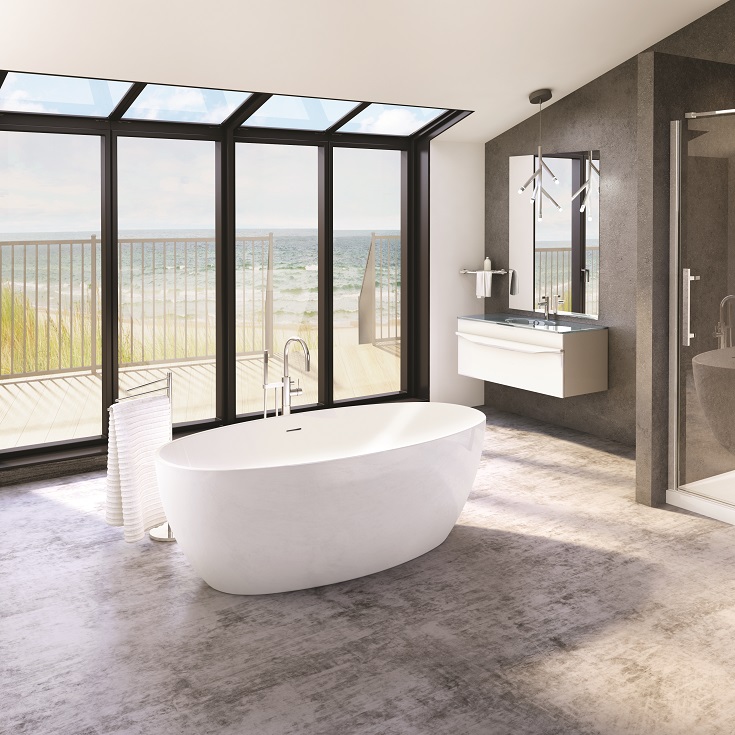
Pro #2 – Freestanding tubs make your bathroom look larger and don’t create a ‘boxed in’ feeling
Since freestanding tubs are not built into a corner or alcove, you can see around all sides of them. They literally show more of your bathroom floor and make a bathroom (visually at least) – live larger.
Even a small bathroom will feel more open, and you won’t feel confined to a tight alcove when bathing.
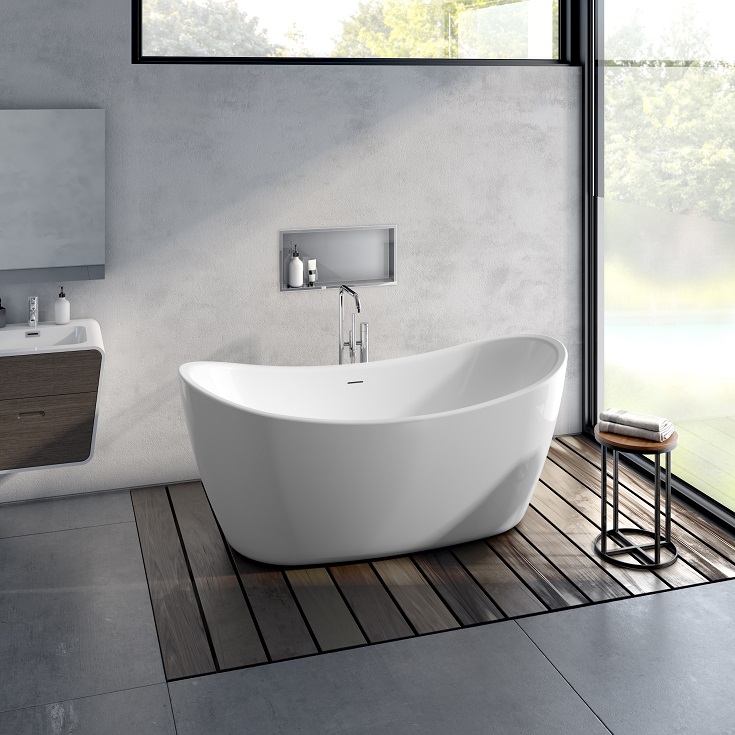
Pro #3 – Freestanding tubs are more comfortable than alcove tubs
Since freestanding tubs are approximately 50% deeper than alcove tubs (the height around the sides ranges from 23” to 44” for a freestanding tub vs. 12” to 18” for alcove tubs) they hold more water. In addition, they provide more inside space (a big bonus for the big and tall people in your family). There’s even designs which work for 2 people at the same time (OK – that sounds like fun).
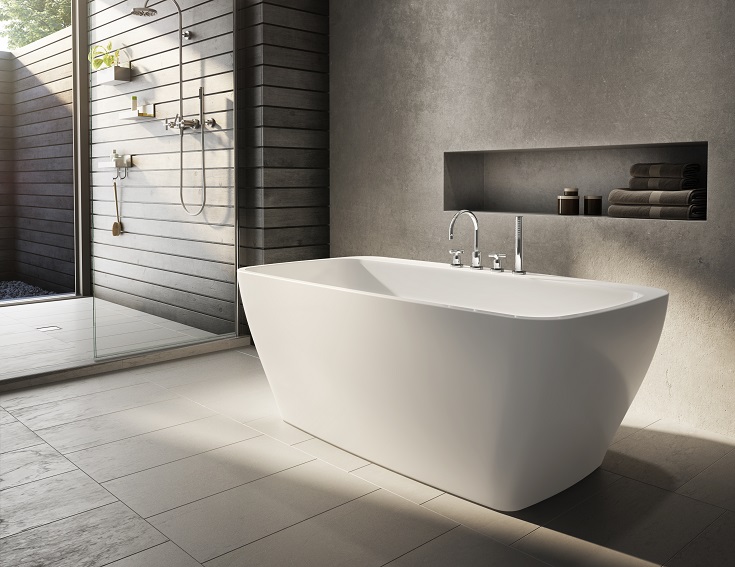
Pro #4 – They come in (seemingly) limitless designs, shapes and sizes and work with any décor
Whether you’re looking for a classic and elegant copper slipper tub for a traditional home, a white porcelain-covered vintage clawfoot tub, or an edgy contemporary acrylic soaking tub for a modern home, you’ll find a wide range of design options.
With a freestanding tub – there’s no reason to settle for plain and boring.

Image Source: Signature Hardware
Pro #5 – You can place a freestanding tub anywhere
Since all sides of a freestanding tub are finished, you have the flexibility of placing them ANYWHERE in the room. Perhaps you want the tub inside an enclosed shower and wet room area. Or perhaps you want to make the tub the focal point of your room and put it smack dab in the middle. Or perhaps you want to place the tub next to a window to enjoy the views of the city, or your rural landscape while sipping your wine.
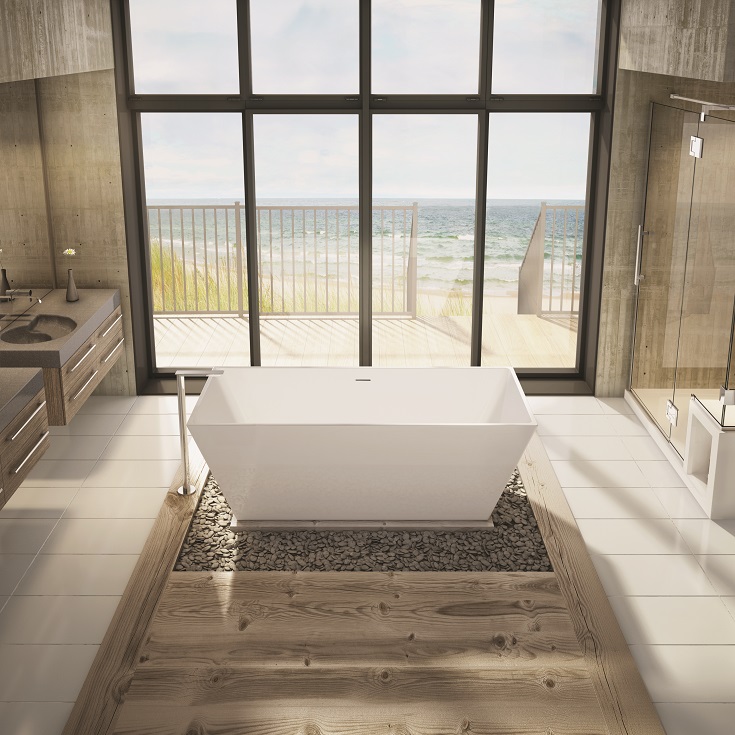
You have perfect flexibility on where to put this tub (and if you ask your supplier for a free tub placement template, this will make the tub location decision even easier).
Pro #6 – It’ll give your home a fresh look and add to its resale value
If you walk into your 1980’s bathroom and are staring at a Jacuzzi tub which hasn’t worked in decades, has steps to climb to get in, tile grout joints which has seen it’s better days (years ago), and everything about it says OLD, OLD, OLD… raise your hand. And if you want a good laugh, check out this ‘wonderful’ Jacuzzi tub project below!
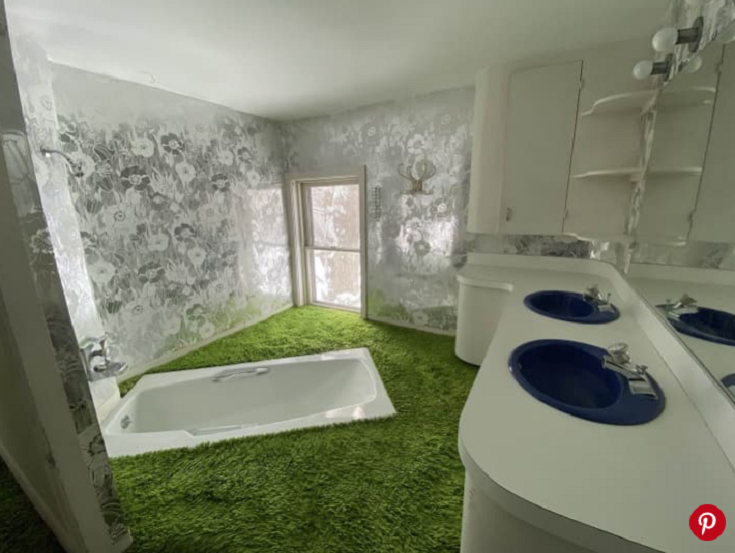
Image Source: Andy Paluch – TPW Real Estate
And there are more of these out-of-date whirlpool tubs from the 1980’s and 1990’s than you can ‘shake a stick at’ (as your grandmother used to say). And the bottom line is…
They look old. They look ugly. They hurt your ability to sell your home.
And if you want an updated look, a smart way to get it is with fashion-forward freestanding tubs. You’ll see them everywhere in Interior Design magazines. They’re smart and they’re current.
Pro #7 – There’s a wide range of material options to choose from
If you love the antique feel of a cast iron clawfoot tub, or the durability of a colored solid surface bathtub, or the sleek (and cost-effective) elegance of an acrylic freestanding tub, these are all possibilities.
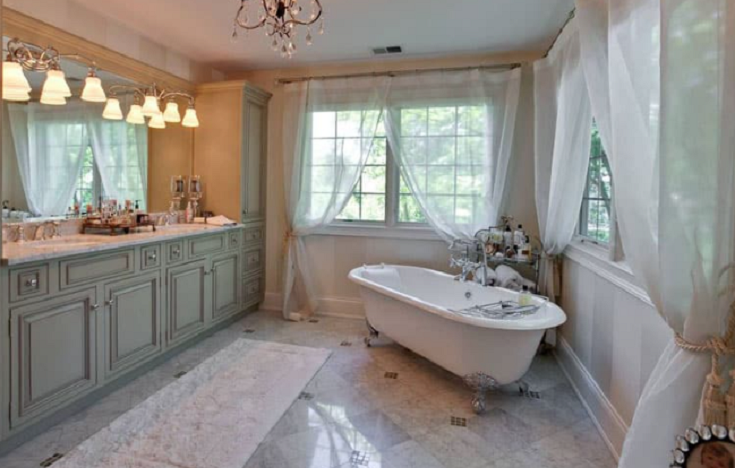
Image Source: Design Idea
There are so many material choices in freestanding tubs (including wood and copper as well) – you won’t have trouble finding your favorite material made in a freestanding tub (although I’ll warn you, prices will vary greatly).
And now – to be balanced, let’s look at the disadvantages (‘er cons) of freestanding soaking tubs.
The Cons of Freestanding Soaking Tubs
Con #1 – They’re more expensive than alcove tubs
Even though you have to add the cost of framing, alcove tubs are still significantly less expensive than a freestanding tub. And if money is tight, a freestanding tub will not be the right option to save a few bucks on your remodel.
Con #2 – They can be heavy and require additional support for your floor
If you choose a solid surface or cast iron freestanding tub you need to know they’re heavy and can require additional support underneath your subfloor. However, if you want a freestanding tub, but don’t want to add structural reinforcements, a smart alternative is an acrylic freestanding bathtub.
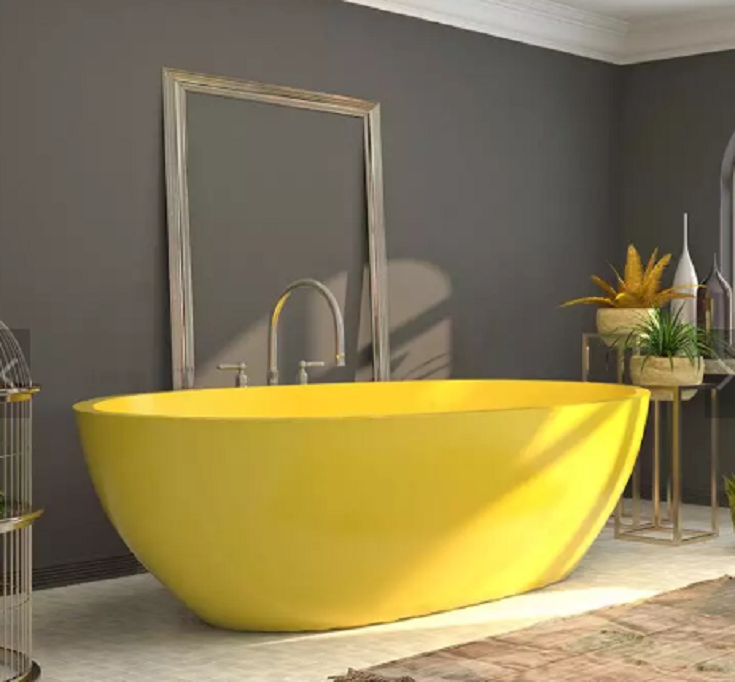
Image Source: Alibaba
Con #3 – Storage for your soap and shampoo can be a challenge
Since most freestanding tubs (except those with deck mount faucets) have no ledges around the unit, you’ll need to use other strategies for your soap and shampoo storage (like rolling caddies or shelves or recessed niches if you’ve placed your tub close to a wall).
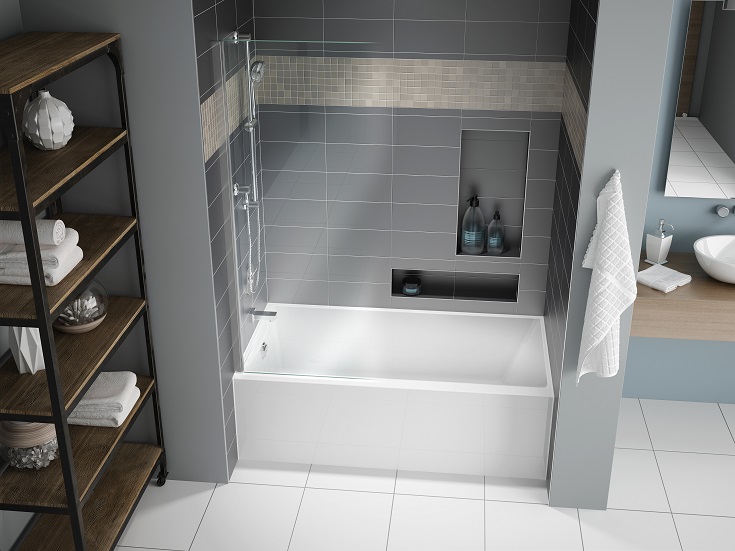
Con #4 – It’s hard to bathe small children or for someone with mobility problems to use
Since the sides of freestanding can range from 23” to 44” high, it’s impractical to bathe a small child in this tub and it’s difficult for a family member with mobility issues to use.
Con #5 – Showering in a freestanding tub isn’t simple
Even though it’s possible to find a ‘shower conversion kit’ to use a freestanding tub as a shower, it’s not the simplest, nor most practical thing to do. You will inevitably get more water on the floor with this make-shift shower arrangement than you will with a built in alcove tub which does double-duty as a shower.
Con #6 – Installing safety grab bars isn’t practical
If you put your freestanding tub in the middle of the room, there’s literally NO PLACE for a grab bar. And if you place the tub close to a wall, you can get a grab bar on one surface, but this placement won’t provide additional support when getting in (or out) of the tub.
OK, – so now that we’ve looked at the advantages and disadvantages of freestanding bathtubs, let’s turn our attention to the pros and cons of built in alcove tubs.
The Pros of a Built-In Alcove Tub
Pro #1 – Alcove tubs are less expensive than freestanding tubs
Since alcove tubs aren’t as big, or finished on all sides, or made with more exotic materials (which can be the case with freestanding tubs), you’ll find they’re significantly less expensive (even with the required framing) than a standalone tub.
Pro #2 – They use less water
While alcove bathtubs can vary greatly in height (with 14” to 16” heights being most popular), depth and design – what’s universally true is they’ll hold significantly less water than a freestanding soaking tub. This is an advantage if you’re focused on conserving water.
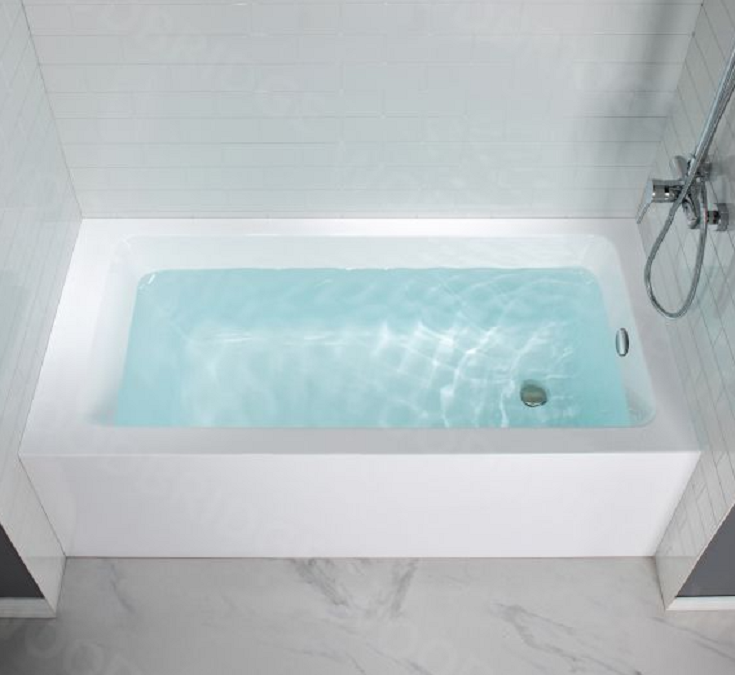
Image Source: Woodbridge Bath
Pro #3 – It can be used as a combination shower and tub
This can be a H-U-G-E benefit of an alcove tub. Since your bathroom may be tighter than you’d like (and if you’re always spewing some ‘choice words’ when running into your partner while getting ready you know what I mean) – being able to get ‘double-duty’ out of your tub can be essential.
And if you have a small bathroom, it’s often impractical to have both a tub and a shower. So, it’s nice to know when you use an alcove tub – it can double as a shower. It’s a BOGO special!
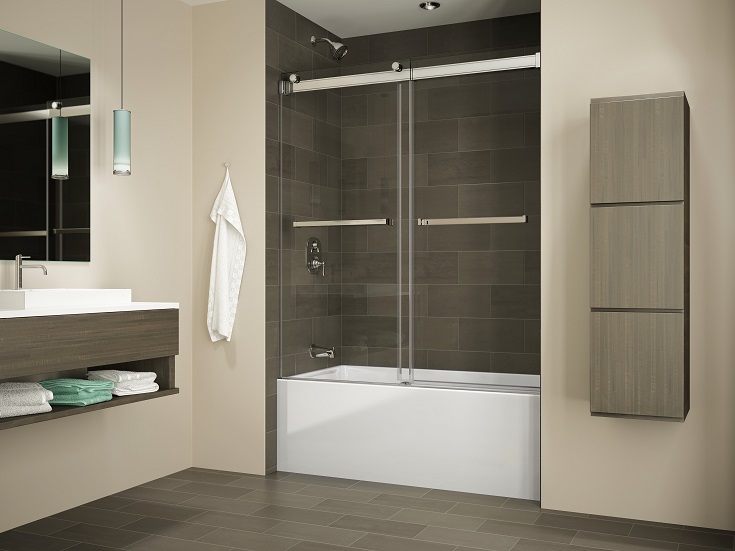
Pro #4 – Storage comes ‘standard.’
If you’re like most people, you don’t have enough space for soaps, shampoos, face creams, loofas, you name it. And with the freestanding tubs discussed earlier you have limited (to no) space for your supplies.
With an alcove tub – on the other hand – there’s a built in ledge for storage. And while this can be helpful, you’ll want to keep in mind it (likely) won’t eliminate the need for other shelves or even a larger horizontal recessed niche like you’ll see below.
Pro #5 – An alcove tub is safer to enter
Since an alcove tub is usually 14” to 16” tall (generally smaller than a freestanding tub), it’s shorter – and simpler to enter. Now, if you’re dealing with a family with mobility issues it still may be better to go with a low profile shower, but if you do need the tub function, a lower ‘skirt’ height (‘er the distance to step into the tub) is smart.
Pro #6 – An alcove tub is simpler to clean
Since you don’t have to bend over as far to clean the bottom of the bathtub, (if you’re the one lucky enough – sarcasm intended – to be ‘charged’ with cleaning your tub), an acrylic alcove tub will be the less painful option to clean.
And certain clawfoot freestanding tubs can be the worst of all because you have to ‘attempt’ to clean under the tub and around the ‘feet’ of the tub as well as cleaning the bottom of the tub.
Pro #7 – You can add bypass tub doors or walk in tub glass to keep the water inside
Since alcove tubs are butted to one or more walls, you can add a bypass glass tub door or walk in glass tub enclosure. This will keep the water inside – where you want it to be. With a freestanding tub there’s not an effective way to use glass to keep water contained.
Pro #8 – Alcove tubs are more space efficient
Since standard alcove tubs are stocked in sizes as small as 60” x 30” and are tucked neatly against the walls (and you don’t need space for a tub filler which is common with freestanding tubs), an alcove tub uses less room than a freestanding tub.
Pro #9 – Ability to keep the existing drain location in a tub replacement project
Since alcove replacement tubs are made with right and left hand drains 8” to 9” from the wall – they have the same ‘footprint’ as the old tubs they’re replacing. This will get rid of your worry about a costly plumber visit to reposition the drain. When it comes to smaller standalone tubs (which can fit in an alcove), many have center drains which requires additional plumbing materials and labor to move the drain.
OK, so now let’s look at the disadvantages (‘er cons) of alcove tubs.
The Cons of a Built-In Alcove Tub
Con #1 – Alcove tubs need to be placed against the walls
Since alcove tubs are (by their definition) placed up against the wall, they don’t give you the (nearly) unlimited placement options of a freestanding bathtub.
Con #2 – These tubs aren’t exciting. They don’t make a ‘statement!’
Don’t you hate it when ‘fancy-schmancy’ designers talk about ‘making a statement?’ And while we may laugh at their ‘more-stylish-than-thou’ attitude,’ they are experienced with products which turn a boring, outdated bathroom into a spa experience.
And while alcove tubs do a wonderful job when it comes to ‘function’ (they’re compact, and double as a shower etc.), when it comes to fashion, they’re woefully inadequate. Sizes, colors, and designs are limited. They’re simply a functional tub built into a corner or a 3-sided alcove. Now, you can make them more exciting with jets, but then you’re adding a lot of cost and complexity.
Con #3 – Alcove tubs aren’t available in as many material options
Since alcove tubs are ‘tucked away,’ and not considered a key bathroom design element, you’ll find them available in fewer exotic materials than with freestanding tubs. They’re more about function than fashion.
Con #4 – You may need to build framed walls to encase your alcove tub
If you don’t already have finished walls for your alcove tub, you’ll have extra costs create them. In a small remodel, this cost can be more significant than you think.
So, do you prefer a freestanding soaking tub or an alcove bathtub? Can we help you decide your best option and/or quote your project?
I hope I didn’t give you TMI (Too Much Information) by listing the advantages and disadvantages of these 2 types of tubs, but I want you to be informed as possible before you spend your hard-earned money on the wrong product. However, now I’d love to hear from you. So, which choice works best for you – the freestanding tub or the built-in alcove tub?
And if you’re still having a hard time deciding, or need prices on these options, let one of the Bathroom Product Specialists at Innovate Building Solutions (OK – I’ll admit that’s my company) help you. Call 877-668-5888 or click for a Free Design Consultation.
And if you’re looking for a contractor to help with your project, ask for a referral for a company in our installing dealer network.
Thanks for reading
Mike
###
If you want more advice (with less wacky humor because you’ll see the ‘buttoned-up’ business version of me) follow me on LinkedIn @MikeFoti.
And if you’re a bathroom remodeling contractor interested in being a dealer of shower wall panels, shower pans and glass shower door systems and purchasing quality shower kits, call 888-467-7488 and ask for Mike.
